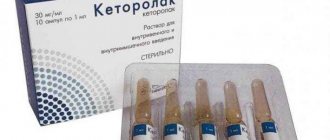Release form and composition
Dosage forms of Lasix:
- Solution for intramuscular and intravenous administration: colorless, transparent (2 ml in dark glass ampoules with a breaking point, 10 ampoules in plastic blister packs, 1 pack in a cardboard box);
- Tablets: round, white or almost white, with “DLI” engraved on one side above and below the marks (10 pieces in aluminum foil strips, 5 strips in a cardboard box; 15 pieces in aluminum foil strips, according to 3 strips in a cardboard box).
1 ml of solution contains:
- Active ingredient: furosemide – 10 mg;
- Auxiliary components: sodium hydroxide, sodium chloride, water for injection.
1 tablet contains:
- Active ingredient: furosemide – 40 mg;
- Auxiliary components: pregelatinized starch, colloidal silicon dioxide, talc, lactose, magnesium stearate, starch.
Lasix price, where to buy
The price of Lasix tablets varies in the range of 50-60 rubles. The solution costs a little more. The price of Lasix in ampoules is approximately 100 rubles.
- Online pharmacies in RussiaRussia
- Online pharmacies in UkraineUkraine
- Online pharmacies in KazakhstanKazakhstan
LuxPharma* special offer
- Lasix tab.
40 mg No. 45 RUR 1,330 order - Lasix solution for injection 2ml 10mg/ml No. 10
RUB 1,480 order
show more
Pharmacy24
- Lasix 40 mg No. 45 tablets Sanofi India Limited, India
42 UAH order - Lasix Neo 10 mg/ml 2 ml No. 10 solution S.S. Zentiva S.A., Rumunia
70 UAH order
PaniPharmacy
- Lasix tablets Lasix tablets. 40 mg No. 45 India, Sanofi India
47 UAH order
- Lasix neo ampoule Lasix NEO solution d/in. 10mg/ml amp. 2ml No. 10 Romania, Zentiva
77 UAH order
show more
Indications for use
For both dosage forms:
- Acute renal failure, including in burn patients and pregnant women (to maintain fluid excretion);
- Edema syndrome in acute or chronic heart failure;
- Edema syndrome in patients with nephrotic syndrome (in addition to the main therapy);
- Edema syndrome in liver diseases (as a single drug or as part of complex therapy in combination with aldosterone antagonists).
Additionally for the solution:
- Edema syndrome in chronic renal failure;
- Brain swelling;
- Hypertensive crisis;
- Poisoning with chemical compounds that are excreted unchanged by the kidneys (to maintain forced diuresis).
Additionally for tablets:
- Arterial hypertension.
Reviews of Lasix
Lasix has established itself as an excellent diuretic and provides immediate relief from edema. However, due to its rapid action, negative effects also appear: the drug washes away microelements even with short-term therapy. One of the advantages is the relatively low cost of both the tablet form and the solution.
Reviews of Lasix for weight loss
The medication really allows you to lose weight without much effort, but the kilograms are reduced due to lost fluid, which is also restored immediately after stopping the medication. In addition, the drug negatively affects water and electrolyte balance, which can negatively affect overall health.
Contraindications
For both dosage forms:
- Hypovolemia (including with arterial hypotension) or dehydration;
- Severe hyponatremia;
- Severe hypokalemia;
- Hepatic precoma and coma;
- Severe disturbances in the outflow of urine of any origin (including unilateral damage to the urinary tract);
- Renal failure with anuria that cannot be corrected with furosemide;
- Pregnancy;
- Lactation period;
- Hypersensitivity to any component of the drug;
- Allergy to sulfonamides - sulfonamide antimicrobial agents and sulfonylureas (since cross-allergy to furosemide is possible).
Additionally for tablets:
- Digitalis intoxication;
- Acute glomerulonephritis;
- Hyperuricemia;
- Increased central venous pressure (above 10 mm Hg);
- Hypertrophic obstructive cardiomyopathy, decompensated mitral and aortic stenosis;
- Children under 3 years of age.
Regardless of the form of release, Lasix is prescribed with caution in the following cases:
- Arterial hypotension;
- Acute myocardial infarction (there is a risk of developing cardiogenic shock);
- Gout;
- Latent or manifest diabetes mellitus;
- Conditions in which an excessive decrease in blood pressure is especially dangerous (for example, stenotic lesions of the cerebral and/or coronary arteries);
- Hepatorenal syndrome;
- Systemic lupus erythematosus;
- History of ventricular arrhythmias;
- Hypoproteinemia (for example, in nephrotic syndrome, when there is a possibility of a decrease in the diuretic effect and an increase in the risk of developing the ototoxic effect of furosemide);
- Pancreatitis, diarrhea;
- Hearing loss;
- Impaired urine outflow (hydronephrosis, narrowing of the urethra, prostatic hyperplasia).
In the form of a solution, the drug is also prescribed with caution to premature babies, because they may develop nephrolithiasis and nephrocalcinosis.
Directions for use and dosage
Doses of Lasix are selected individually in each case. It is always necessary to use the least effective dose that is sufficient to achieve the desired therapeutic effect.
The solution is administered mainly intravenously (IV), in very rare cases - intramuscularly (IM). In this case, intravenous administration is indicated only in cases where oral administration of furosemide is impossible, the patient has a malabsorption of the drug in the small intestine, or it is necessary to obtain the effect as quickly as possible. As soon as the opportunity arises, the patient is transferred to Lasix in tablet form.
The maximum rate of intravenous administration is 4 mg/minute, for patients with severe renal failure - 2.5 mg/minute. To suppress counter-regulation and achieve optimal effectiveness, continuous infusion of the drug is preferable. If, after one or more bolus intravenous injections in acute conditions, a continuous intravenous infusion is not possible, it is recommended to administer low doses of furosemide at short intervals (approximately 4 hours).
Saline solution can be used to dilute the Lasix solution. It should be prepared immediately before use.
The maximum daily dose for intravenous administration is: for adults – 1500 mg, for children – 1 mg/kg, but not more than 20 mg/day.
The duration of treatment in each case is determined by the doctor.
Special dosage recommendations for adults:
- Edema syndrome in acute heart failure, hypertensive crisis, cerebral edema: initial dose - 20-40 mg as an intravenous bolus. Subsequently, the dose is adjusted depending on the therapeutic effect;
- Edema syndrome in chronic heart failure: initial dose – 20-80 mg per day, the required dose is determined depending on the diuretic effect and is divided into 2-3 administrations;
- Edema in nephrotic syndrome: initial daily dose – 20-40 mg, subsequently selected taking into account the diuretic response;
- Acute renal failure: initial dose – 40 mg. If there is no required diuretic effect, the drug is administered as a continuous intravenous infusion at a rate of 50-100 mg/hour;
- Edema syndrome in chronic renal failure: particularly careful selection of doses is required, starting with the minimum and gradually increasing them. Treatment begins with intravenous drip at a rate of 0.1 mg/minute and increases it every 30 minutes depending on the therapeutic effect. Typically, the daily maintenance dose for patients on hemodialysis is 250-1500 mg;
- Edema syndrome in liver diseases (only if IV administration is absolutely necessary): initial dose – 20-40 mg;
- Maintaining forced diuresis in case of poisoning (after intravenous infusion of electrolyte solutions): initial dose – 20-40 mg.
Lasix tablets should be taken orally, without chewing, with water, on an empty stomach.
Maximum daily dose for oral administration: for adults – 1500 mg, for children – 2 mg/kg, but not more than 40 mg/day. The duration of treatment is determined by the doctor depending on the indications.
Special dosage recommendations for adults:
- Edema syndrome in chronic heart failure and liver diseases: initial daily dose – 20-80 mg in 2-3 doses;
- Edema syndrome in chronic renal failure, edema in nephrotic syndrome: initial daily dose – 40-80 mg in 1-2 doses. For hemodialysis patients, the maintenance dose is usually 250 to 1500 mg per day;
- Acute renal failure: the dose in tablets depends on the selected intravenous dose;
- Arterial hypertension: maintenance daily dose – 20-40 mg. If the disease is combined with chronic renal failure, higher doses of furosemide may be required.
Pharmacokinetic properties
What kinetic parameters are inherent in the drug “Lasix” (in ampoules)? Instructions for use indicate that the volume of distribution of the active substance of the drug is 0.1-0.2 l per 1 kg of patient weight.
Furosemide binds well to proteins and is excreted unchanged through secretion in the proximal tubules.
The terminal half-life of this drug after intravenous infusion is approximately one and a half hours. The main ingredient of the drug is excreted in breast milk and penetrates the placental barrier.
Side effects
Possible side effects associated with Lasix:
- Water-electrolyte and acid-base balance: metabolic alkalosis, hypokalemia, hypochloremia, hypomagnesemia, hyponatremia, hypocalcemia (accompanied by symptoms such as headache, muscle weakness, cramps, confusion, tetany, dyspeptic disorders, cardiac arrhythmias), dehydration and hypovolemia (more often in older people);
- Cardiovascular system: excessive decrease in blood pressure (manifested, especially in elderly patients, by the following symptoms: a feeling of “emptiness” in the head, a feeling of pressure in the head, impaired reactions and concentration, drowsiness, headache, weakness, dizziness, dry mouth , visual disturbances, impaired orthostatic regulation of blood circulation), arrhythmias, tachycardia, collapse, decreased circulating blood volume;
- Metabolism: decreased glucose tolerance (possible manifestation of latent diabetes mellitus), transient increase in the level of urea and creatinine in the blood, increased serum concentrations of triglycerides and cholesterol, increased serum concentration of uric acid, which can increase symptoms or cause gout;
- Urinary system: intensification or appearance of symptoms due to partial obstruction of the urinary tract; rarely – interstitial nephritis, nephrolithiasis/nephrocalcinosis in premature infants;
- Digestive system: rarely – diarrhea, vomiting, nausea; in some cases - intrahepatic cholestasis, increased levels of liver enzymes, acute pancreatitis;
- Central nervous system, organ of hearing: rarely - paresthesia, hearing impairment (usually reversible), tinnitus (especially in patients with nephrotic syndrome and renal failure, or in the case of rapid intravenous administration of Lasix);
- Peripheral blood: rarely - thrombocytopenia, eosinophilia, leukopenia; in some cases - aplastic or hemolytic anemia, agranulocytosis;
- Skin, allergic reactions: rarely - skin manifestations: itching, erythema multiforme, urticaria, bullous skin lesions or other types of rash, purpura, vasculitis, exfoliative dermatitis, photosensitivity, fever; extremely rarely - severe anaphylactoid or anaphylactic reactions, up to shock (were noted only after intravenous administration);
- Local reactions with intramuscular injection - pain at the injection site;
- Others: in premature infants in the first weeks of life there is a risk of persistence of the ductus Botallova.
special instructions
Before starting treatment with Lasix, it is necessary to exclude the presence of pronounced disturbances in the outflow of urine, even unilateral ones. Patients with partial obstruction of urinary outflow should be closely monitored.
Before and during use of the drug, dehydration or hypovolemia, as well as clinically significant disturbances in acid-base and/or electrolyte status, should be monitored and, if developed, corrected. Sometimes this requires short-term withdrawal of furosemide.
During therapy, it is necessary to regularly monitor serum concentrations of potassium, creatinine and sodium, especially in patients with a high risk of developing electrolyte imbalance due to additional losses of fluid and electrolytes, for example, due to diarrhea, vomiting or intense sweating.
During treatment, it is recommended to eat foods rich in potassium, for example, potatoes, meat, tomatoes, spinach, cauliflower, bananas, dried fruits. In some cases, potassium supplements or potassium-sparing agents are additionally prescribed.
Premature babies require regular ultrasound examination of the kidneys and monitoring of their function, because there is a possibility of developing nephrolithiasis and nephrocalcinosis.
Dose selection for patients with ascites that has developed against the background of liver cirrhosis is carried out in the hospital, since disturbances in the water-electrolyte state can lead to hepatic coma.
Lasix solution cannot be mixed in the same syringe with other medications.
Some side effects (for example, symptoms that accompany a significant decrease in blood pressure) may impair reaction time and the ability to concentrate, which can be dangerous when operating machinery or driving vehicles. This is especially true for the beginning of treatment and the period of increasing the dose, as well as cases of concomitant use of antihypertensive drugs or alcoholic beverages.
Overdose
Clinically, acute and chronic overdoses may present differently depending on the level of electrolyte and fluid loss. The most commonly recorded manifestations are:
- dehydration;
- acute renal failure;
- hypovolemia;
- delirium;
- hemoconcentration;
- thrombosis;
- cardiac rhythm and conduction disturbances (ventricular fibrillation, atrioventricular block );
- apathy;
- flaccid paralysis;
- confusion;
- drop in blood pressure.
Therapy is aimed at correcting disturbances in the acid-base balance, water and electrolyte status under the mandatory control of hematocrit and electrolytes.
Drug interactions
Possible interaction reactions when using Lasix simultaneously with other drugs:
- Cardiac glycosides and drugs that prolong the QT interval - increased toxicity in patients with electrolyte disturbances (hypokalemia or hypomagnesemia);
- Laxatives taken for a long time, licorice in large quantities, glucocorticosteroids and carbenoxolone - the risk of developing hypokalemia;
- Aminoglycosides – slowing their elimination, increasing the risk of nephrotoxic and ototoxic effects;
- High doses of some cephalosporins (especially those with a predominantly renal route of elimination), drugs with nephrotoxic effects - the likelihood of developing their nephrotoxic effect;
- Cisplatin – the risk of its ototoxic effect, and when taking furosemide in a dose of more than 40 mg – the likelihood of nephrotoxic effect of cisplatin;
- Non-steroidal anti-inflammatory drugs (including acetylsalicylic acid) - reducing the diuretic effect of furosemide; in patients with hypovolemia and dehydration (including those developed as a result of Lasix use), the development of acute renal failure; increased toxic effects of salicylates;
- Phenytoin – decreased effectiveness of furosemide;
- Antihypertensive drugs, diuretics or other drugs that can lower blood pressure - enhancing their hypotensive effect;
- Hypoglycemic agents, pressor amines (norepinephrine and epinephrine) – decrease in their effectiveness;
- Angiotensin-converting enzyme (ACE) inhibitors - excessive decrease in blood pressure and deterioration of kidney function, in some cases - the development of acute renal failure;
- Methotrexate, probenecid and other drugs secreted in the renal tubules - a decrease in their excretion by the kidneys, a decrease in the effectiveness of furosemide;
- Curare-like muscle relaxants, diazoxide, theophylline - enhancing their effects;
- Lithium salts – decreased excretion of lithium, increased its serum concentration and development of toxic effects, incl. damaging effects on the nervous system and heart;
- Sucralfate – decreased absorption of furosemide and weakened its effect;
- Cyclosporine A - increases the risk of impaired urate excretion by the kidneys and the development of gouty arthritis due to hyperuricemia caused by furosemide;
- X-ray contrast agents – risk of renal dysfunction.
Features of the medicine
What features are characteristic of the drug "Lasix" (in ampoules)? The instructions for use state that in heart failure, this medicine reduces the load, as well as the pressure in the artery (pulmonary) and the filling of the left ventricle. In addition, this drug has a hypotensive effect, which is due to a decrease in blood volume (circulating), an increase in sodium excretion and a decrease in the response of muscle (smooth) vessels to vasoconstrictor effects.
Dose-dependent natriuresis and diuresis are observed when taking the drug at a dosage of 10-100 mg. After intravenous administration of 20 mg of the drug, the diuretic effect is observed after ¼ hour and lasts for 180 minutes.
Long-term infusion of this drug is more effective than repeated bolus administration. It should also be noted that when the dosage of the drug is exceeded, a significant increase in the effect in patients is not observed.





